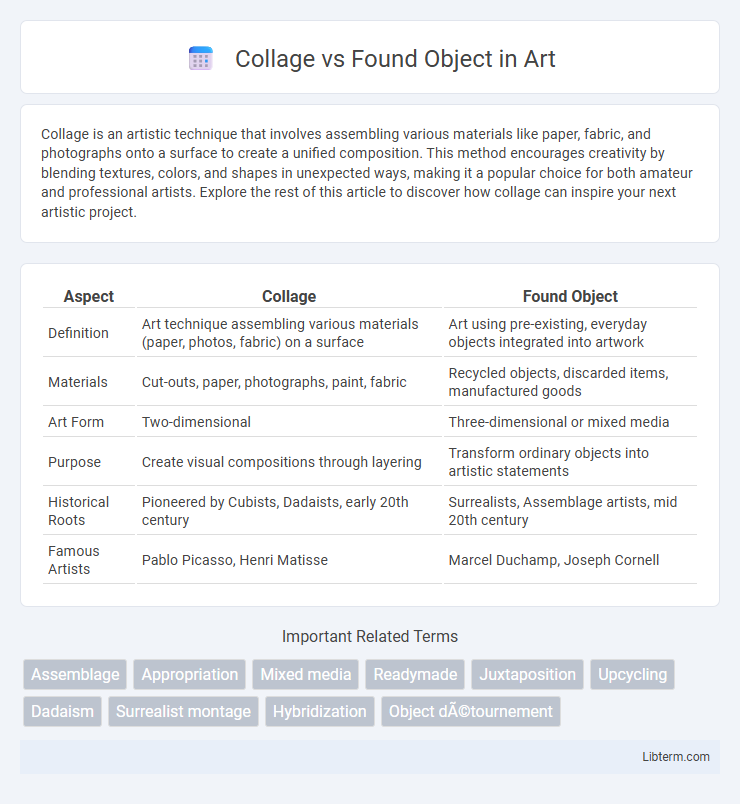Collage is an artistic technique that involves assembling various materials like paper, fabric, and photographs onto a surface to create a unified composition. This method encourages creativity by blending textures, colors, and shapes in unexpected ways, making it a popular choice for both amateur and professional artists. Explore the rest of this article to discover how collage can inspire your next artistic project.
Table of Comparison
| Aspect | Collage | Found Object |
|---|---|---|
| Definition | Art technique assembling various materials (paper, photos, fabric) on a surface | Art using pre-existing, everyday objects integrated into artwork |
| Materials | Cut-outs, paper, photographs, paint, fabric | Recycled objects, discarded items, manufactured goods |
| Art Form | Two-dimensional | Three-dimensional or mixed media |
| Purpose | Create visual compositions through layering | Transform ordinary objects into artistic statements |
| Historical Roots | Pioneered by Cubists, Dadaists, early 20th century | Surrealists, Assemblage artists, mid 20th century |
| Famous Artists | Pablo Picasso, Henri Matisse | Marcel Duchamp, Joseph Cornell |
Understanding Collage and Found Object Art
Collage art involves assembling various materials such as paper, photographs, and fabric onto a surface to create a unified composition, emphasizing texture and juxtaposition. Found object art incorporates everyday or discarded items, transforming them into three-dimensional artworks that challenge traditional materials and contexts. Both styles prioritize creativity and reinterpretation, with collage focusing on layering and visual storytelling, while found object art highlights the transformative potential of ordinary objects.
Historical Origins of Collage and Found Objects
Collage originated in the early 20th century, notably popularized by artists like Pablo Picasso and Georges Braque during the Cubist movement, who integrated newspaper clippings and fabric into their paintings to challenge traditional art forms. Found objects, or objets trouves, emerged earlier in the late 19th century with artists like Marcel Duchamp, who redefined everyday manufactured items as art by presenting them in new contexts, exemplified by his 1917 work "Fountain." The historical development of collage and found objects reflects a critical shift in modern art toward incorporating real-world materials and questioning the boundaries of artistic creativity.
Key Techniques in Collage Creation
Key techniques in collage creation include layering diverse materials such as paper, fabric, and photographs to build complex textures and visual depth. Artists often employ cutting, tearing, and assembling fragments to create unexpected juxtapositions and narrative contrasts. Found objects can be incorporated for added dimension, but traditional collage emphasizes two-dimensional arrangement and manipulation of flat elements.
Approaches to Found Object Assemblage
Found object assemblage emphasizes recontextualizing everyday materials, transforming discarded or ordinary items into cohesive artistic expressions that challenge traditional boundaries of sculpture and collage. This approach prioritizes physical texture, material history, and conceptual layering, allowing artists to invoke narratives through the unexpected juxtaposition of three-dimensional objects. In contrast to collage's flat, paper-based montage techniques, found object assemblage integrates tactile, diverse elements to create immersive, multidimensional compositions.
Materials Used in Collage vs Found Object Art
Collage art primarily uses materials such as paper, fabric, photographs, and printed media layered onto a support surface, emphasizing texture and visual complexity. Found object art incorporates everyday items like metal scraps, wood pieces, plastic, and discarded objects, transforming them into sculptural compositions with inherent meaning. The choice of materials in collage centers on flat, malleable elements for two-dimensional assembly, whereas found object art relies on three-dimensional, pre-existing items to create tactile and conceptual statements.
Artistic Intent and Conceptual Differences
Collage involves assembling various materials such as paper, photographs, and fabric to create a unified composition that often explores themes through juxtaposition and layering, emphasizing control over visual and thematic elements. Found object art incorporates everyday, pre-existing items, repurposing them to challenge traditional aesthetics and provoke conceptual dialogues about context, value, and meaning. The artistic intent in collage centers on deliberate synthesis of diverse fragments to build a narrative or abstraction, whereas found object art relies on recontextualization to transform objects into symbolic or critical statements.
Major Artists in Collage and Found Object Movements
Major artists in the collage movement include Pablo Picasso and Georges Braque, who pioneered Cubist techniques integrating newspaper, fabric, and other materials into their paintings. In the found object movement, Marcel Duchamp stands out for his "Readymades," such as "Fountain," which repurposed everyday objects as art. Contemporary figures like Robert Rauschenberg blurred boundaries by combining collage elements with found objects, further advancing mixed media art.
Visual Impact: Comparing Aesthetics
Collage and found object art differ significantly in visual impact, with collage emphasizing layered, two-dimensional arrangements that create intricate textures and combined imagery, while found object art relies on the three-dimensionality and inherent context of everyday materials. Collage offers vibrant, complex compositions through the juxtaposition of diverse paper elements, enhancing narrative and visual depth. Found object art captivates viewers by transforming ordinary objects into unexpected, tactile sculptures that challenge traditional aesthetics and engage spatial perception.
Cultural and Social Significance
Collage and found object art both reflect cultural and social narratives by repurposing everyday materials, highlighting themes of consumerism, identity, and memory through tactile assemblage. Collage integrates diverse media and imagery to critique or celebrate cultural phenomena, while found objects bring inherent historical and symbolic meanings that challenge traditional art boundaries. Together, they underscore shifting societal values and invite dialogue on material culture and collective experience.
Choosing Between Collage and Found Object in Contemporary Art
Choosing between collage and found object in contemporary art depends on the intended expression and material interaction; collage emphasizes the layering and juxtaposition of paper, photographs, or digital elements. Found object art involves integrating everyday manufactured items, transforming them into art through contextual redefinition and spatial presence. Artists must evaluate the conceptual impact and tactile engagement to select the medium that best conveys their artistic vision.
Collage Infographic

 libterm.com
libterm.com